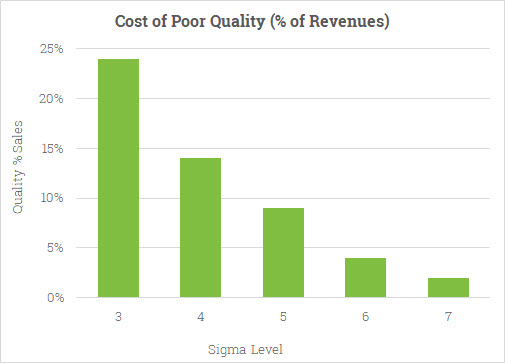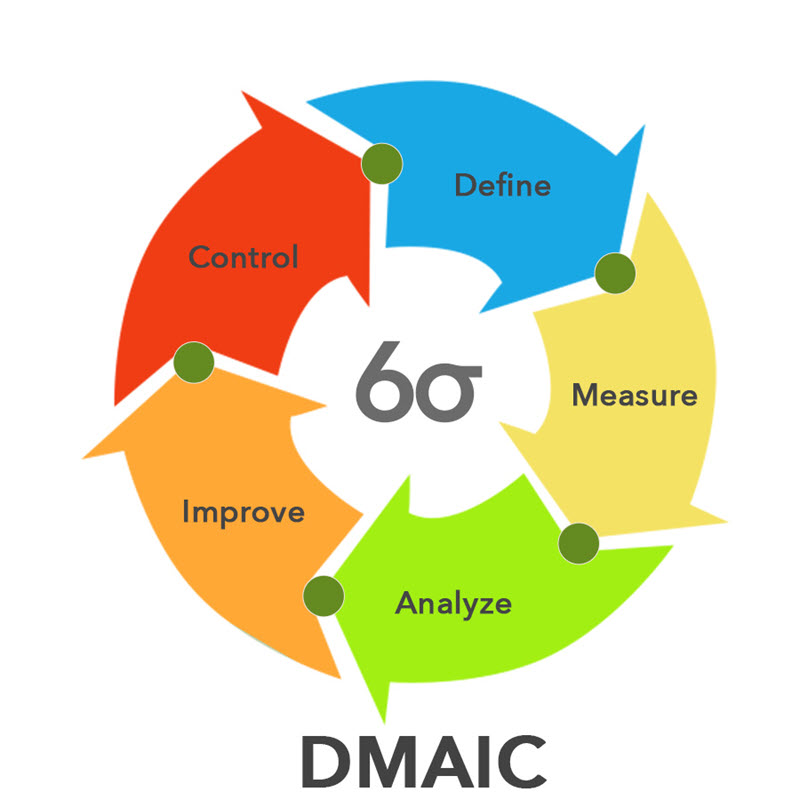For Motorola, the originator of Six Sigma, the answer to the question “Why Six Sigma?” was simple: survival. Motorola came to Six Sigma because it was being consistently beaten in the competitive marketplace by foreign firms that were able to produce higher quality products at a lower cost. When a Japanese firm took over a Motorola factory that manufactured Quasar television sets in the United States in the 1970s, they promptly set about making drastic changes in the way the factory operated. Under Japanese management, the factory was soon producing TV sets with 1/20th the number of defects they had produced under Motorola management. They did this using the same workforce, technology, and designs, making it clear that the problem was Motorola’s management. Eventually, even Motorola’s own executives had to admit “our quality stinks.”
Finally, in the mid 1980s, Motorola decided to take quality seriously. Motorola’s CEO at the time, Bob Galvin, started the company on the quality path known as Six Sigma and became a business icon largely as a result of what he accomplished in quality at Motorola. Today, Motorola is known worldwide as a quality leader. After Motorola won the Malcolm Baldrige National Quality Award in 1988 the secret of their success became public knowledge and the Six Sigma revolution was born. Today Six Sigma hotter than ever.
Six Sigma Training Today
It would be a mistake to think that Six Sigma is about quality in the traditional sense. Quality, defined traditionally as conformance to internal requirements, has little to do with Six Sigma. Six Sigma is about helping the organization make more money. To link this objective of Six Sigma with quality requires a new definition of quality. For Six Sigma purposes I define quality as the value added by a productive endeavor.
Quality comes in two flavors: potential quality and actual quality. Potential quality is the known maximum possible value added per unit of input. Actual quality is the current value added per unit of input. The difference between potential and actual quality is waste.
Six Sigma focuses on improving quality (i.e., reduce waste) by helping organizations produce products and services better, faster and cheaper. Six Sigma focuses on improving customer loyalty, reducing errors, improving cycle times, and reducing costs by eliminating non-value added activities.
Unlike mindless cost-cutting programs which reduce value and quality as well as costs, Six Sigma identifies and eliminates costs which provide no value to customers, waste costs. For non-Six Sigma companies, these costs are often extremely high and usually unknown. Companies operating at three or four sigma typically spend between 25 and 40 percent of their revenues fixing problems. This is known as the cost of quality, or more accurately the cost of poor quality. Companies operating at Six Sigma typically spend less than 5 percent of their revenues fixing problems (Figure 1). The dollar cost of this gap can be huge. General Electric estimates that the gap between three or four sigma and Six Sigma was costing them between $8 billion and $12 billion per year.

What is Six Sigma and How Does It Work?
Six Sigma is a rigorous, focused and highly effective implementation of proven quality principles and techniques. Incorporating elements from the work of many quality pioneers, Six Sigma aims for virtually error free business performance. Sigma, σ, is a letter in the Greek alphabet used by statisticians to measure the variability in a data set. In Six Sigma these data sets normally consist or process performance metrics. A company’s performance is measured by the sigma level of their business processes. Traditionally companies accept three or four sigma performance levels as the norm, despite the fact that these processes create between 6,200 and 67,000 problems per million opportunities! The Six Sigma standard of 3.4 problems per million opportunities is a response to the increasing expectations of customers and the increased complexity of modern products and processes.

If you’re looking for new techniques, you won’t find them. Six Sigma’s magic isn’t in statistical or high-tech razzle-dazzle. Six Sigma relies on tried and true methods that have been around for decades. In fact, Six Sigma discards a great deal of the complexity that characterized its predecessor, Total Quality Management (TQM.) By one expert’s count, there were over 400 TQM tools and techniques. Six Sigma takes a handful of proven methods and trains a small cadre of in-house technical leaders, known as Six Sigma Black Belts and Six Sigma Green Belts, to a high level of proficiency in the application of these techniques. To be sure, some of the methods used by Six Sigma Black Belts are highly advanced, including the use of up-to-date computer technology and software. But the tools are applied within a simple performance improvement model known as DMAIC, or Define-Measure-Analyze-Improve-Control. What is DMAIC Methodology is a question we hear often. DMAIC can be described as follows:
| D | Define the goals of the Six Sigma improvement activity. At the top level the goals will be the strategic objectives of the organization, such as a higher ROI or market share. At the operations level, a goal might be to increase the throughput of a production department. At the project level goals might be to reduce the defect level and increase throughput. The goals at one level are linked to those at higher and lower levels. Six Sigma Master Black Belts may also apply data mining methods to identify potential improvement opportunities. |
| M | Measure the existing system. Establish valid and reliable metrics to help monitor progress towards the goal(s) defined at the previous step. Begin by determining the current baseline. Use exploratory and descriptive data analysis to help you understand the data. Drill down from the desired results to the major drivers of the results. These drivers are called critical to quality characteristics, or CTQs. |
| A | Analyze the system to identify ways to eliminate the gap between the current performance of the system or process and the desired goal. Apply statistical tools to guide the analysis and validate the conclusions. Use Lean Six Sigma to create flow. |
| I | Improve the system. Be creative in finding new ways to do things better, cheaper, or faster. Use project management and other planning and management tools to implement the new approach. Use statistical methods to validate the improvement. Apply Lean principles to the design of the new value stream and processes. |
| C | Control the new system. Institutionalize the improved system by modifying compensation and incentive systems, policies, procedures, MRP, budgets, operating instructions and other management systems. Standardize the new process to facilitate Lean production. You may wish to utilize systems such as ISO 9000 to assure that documentation is correct. |
Six Sigma Infrastructure
A very powerful feature of Six Sigma is the creation of an infrastructure to assure that performance improvement activities have the necessary resources. In this author’s opinion, failure to provide this infrastructure is the #1 reason why 80% of all TQM implementations failed in the past. Six Sigma makes improvement and change the full-time job of a small but critical percentage of the organization’s personnel. These full time Six Sigma change agents are the catalyst that institutionalizes change. Figure 2 illustrates the required human resource commitment required by Six Sigma.

Six Sigma Leadership
Six Sigma involves changing major business value streams that cut across organizational barriers. It is the means by which the organization’s strategic goals are to be achieved. This effort cannot be led by anyone other than the CEO, who is responsible for the performance of the organization as a whole. Six Sigma must be implemented from the top-down. Deployments can start at middle or lower levels, but the impact on the overall performance of the organization will be limited.
Six Sigma Champions and Sponsors
Six Sigma champions are high-level leaders who understand Six Sigma and are committed to its success. In larger organizations Six Sigma will be led by a full time, high level Six Sigma champion, such as an Executive Vice-President. Champions include informal leaders who use Six Sigma in their day-to-day work and communicate the Six Sigma message at every opportunity. Sponsors are owners of processes and systems who help initiate and coordinate Six Sigma improvement activities in their areas of responsibilities.
Six Sigma Master Black Belt
This position represents the highest level of technical and organizational proficiency. Six Sigma Master Black Belts provide technical leadership of the Six Sigma program. Thus, they must know everything the Six Sigma Black Belts know, as well as understand the mathematical theory on which the statistical methods are based. Six Sigma Master Black Belts generally have a special area of proficiency that is valuable to the Six Sigma program. For example, project management skill, coaching skill, finance expertise, a talent for training, and so on. Six Sigma Master Black Belts must be able to assist Six Sigma Black Belts in applying the methods correctly in unusual situations. Whenever possible, statistical training should be conducted only by Master Black Belts. Otherwise the familiar “propagation of error” phenomenon will occur, i.e., Six Sigma Black Belts pass on errors to Six Sigma Green Belts, who pass on greater errors to team members. If it becomes necessary for Six Sigma Black Belts and Six Sigma Green Belts to provide training, they should do only so under the guidance of Six Sigma Master Black Belts. For example, Six Sigma Black Belts may be asked to provide assistance to the Master during class discussions and exercises. Because of the nature of the Master’s duties, communications and teaching skills are as important as technical competence.
Six Sigma Black Belt
Candidates for Six Sigma Black Belt status are technically oriented individuals held in high regard by their peers. They should be actively involved in the process of organizational change and development. Candidates may come from a wide range of disciplines and need not be formally trained statisticians or engineers. However, because they are expected to master a wide variety of technical tools in a relatively short period of time, Six Sigma Black Belt candidates will probably possess a background in college-level mathematics, the basic tool of quantitative analysis. Coursework in statistical methods should be considered a strong plus or even a prerequisite. As part of their training, Six Sigma Black Belts receive 160 hours of classroom instruction (four weeks,) plus one-on-one project coaching from Master Black Belts or consultants. If the organization is using Lean Six Sigma, the training period is normally five weeks.
Successful candidates will be comfortable with computers. At a minimum, they should understand one or more operating systems, spreadsheets, database managers, presentation programs, and word processors. As part of their training they will be required to become proficient in the use of one or more advanced statistical analysis software packages. Six Sigma Black Belts work to extract actionable knowledge from an organization’s information warehouse. To assure access to the needed information, Six Sigma activities should be closely integrated with the information systems (IS) of the organization. Obviously, the skills and training of Six Sigma Black Belts must be enabled by an investment in software and hardware. It makes no sense to hamstring these experts by saving a few dollars on computers or software.
Six Sigma Green Belt
Six Sigma Green Belts are Six Sigma project leaders capable of forming and facilitating Six Sigma teams and managing Six Sigma projects from concept to completion. Six Sigma Green Belt training consists of a minimum of five days of classroom training and is conducted in conjunction with Six Sigma projects. Training covers project management, quality management tools, quality control tools, problem solving, and descriptive data analysis. Usually, Six Sigma Black Belts help Six Sigma Green Belts define their projects prior to the training, attend training with Six Sigma Green Belts, and assist them with their projects after the training.
Yellow, White and Other Six Sigma Belts
In addition to the Six Sigma change agent belts mentioned above, there are other colors of Six Sigma belts who receive a certain amount of training, but are not expected to lead Six Sigma teams or complete Six Sigma projects. These Six Sigma belts receive training primarily to enable them to work in Six Sigma support roles as stakeholders, sponsors, team members, team consultants, and so on. Six Sigma champions should attend Six Sigma Yellow Belt or Six Sigma White Belt training. At least one large company I know of (a client) has their senior leaders attend Six Sigma Black Belt training. I was skeptical of this, but those leaders who have gone through the training are very pleased with the requirement.
Staffing Levels and Expected Returns
Relatively few full time personnel are devoted to Six Sigma. Mature Six Sigma programs, such as those of Motorola, General Electric, Johnson & Johnson, AlliedSignal, and others average about one-percent of their workforce as Six Sigma Black Belts. There is usually about one Six Sigma Master Black Belt for every ten Six Sigma Black Belts, or about 1 Six Sigma Master Black Belt per 1,000 employees. A Six Sigma Black Belt will typically complete 5 to 7 Six Sigma projects per year. Six Sigma Project teams are also led by Six Sigma Green Belts, who, unlike Six Sigma Black Belts and Six Sigma Master Black Belts, are not employed full time in the Six Sigma program. Six Sigma Black Belts are highly prized employees and are often recruited for key management positions elsewhere in the company. After Six Sigma has been in place for three or more years, former Six Sigma Black Belts and Six Sigma Green Belts populate a sufficient number of key positions in the organization to change the organization’s DNA. In other words, management by facts and data, rather than by politics and personalities, starts to dominate.
Estimated savings per project varies from organization to organization. Reported results average about US$150,000 to US$243,000. My experience is that the average Six Sigma Black Belt project will produce a net benefit of around $200,000 in mature programs, but I have seen a single project in a new Six Sigma program net as much as $2.5 million. Six Sigma Green Belt projects produce an average of about $75,000 per year and each Six Sigma Green Belt will complete about two projects per year.
Note that these are not huge mega-projects, but such large projects tend to have a high failure rate anyway. Still, by completing 5 to 7 projects per year per Six Sigma Black Belt the company will add in excess of US$1 million per year per Six Sigma Black Belt to its bottom line. Six Sigma Green Belts will contribute about $75,000 each in benefits.
For a company with 1,000 employees the numbers would look something like this:
- Six Sigma Master Black Belts: 1
- Six Sigma Black Belts: 10
- Six Sigma Black Belt Projects: = 50 to 70 (5 to 7 per Six Sigma Black Belt)
- Six Sigma Green Belts: 50
- Six Sigma Green Belt Projects: 100 with $50,000-$100,00 per project benefits
- Estimated saving: US$13,750,000 million (US$13,750 per employee)
Do the math for your organization and see what Six Sigma could do for you. Because Six Sigma savings impact only non-value added costs, they flow directly to your company’s bottom line.
Implementation of Lean Six Sigma
After over three decades of experience with quality improvement, there is now a solid body of scientific research regarding the experience of thousands of companies implementing major programs such as Six Sigma. Researchers have found that successful deployment of Six Sigma involves focusing on a small number of high-leverage items. The steps required to successfully implement Six Sigma are well-documented.
- Successful performance improvement must begin with senior leadership. Start by providing senior leadership with training in the principles and tools they need to prepare their organization for success. Using their newly acquired knowledge, senior leaders direct the creation of a management infrastructure to support Six Sigma. Simultaneously, steps are taken to “soft-wire” the organization and to cultivate an environment for innovation and creativity. This involves reducing levels of organizational hierarchy, removing procedural barriers to experimentation and change, and a variety of other changes designed to make it easier to try new things without fear of reprisal for failure.
- Systems are developed for establishing close communication with customers, employees, and suppliers. This includes developing rigorous methods of obtaining and evaluating customer, employee and supplier input. Base line studies are conducted to determine the starting point and to identify cultural, policy, and procedural obstacles to success.
- Training needs are rigorously assessed. Remedial basic skills education Is provided to assure that adequate levels of literacy and numeracy are possessed by all employees. Top-to-bottom training is conducted in systems improvement tools, techniques, and philosophies.
- A framework for continuous process improvement is developed, along with a system of indicators for monitoring progress and success. Six Sigma metrics focus on the organization’s strategic goals, drivers, and key business processes.
- Business processes to be improved are chosen by management, and by people with intimate process knowledge at all levels of the organization. Six Sigma projects are conducted to improve business performance linked to measurable financial results. This requires knowledge of the organization’s constraints.
- Six Sigma projects are conducted by individual employees and teams lead by Six Sigma Green Belts and assisted by Six Sigma Black Belts.
Although the approach is simple, it is by no means easy. But the results justify the effort expended. Research has shown that firms that successfully implement Six Sigma perform better in virtually every business category, including return on sales, return on investment, employment growth, and share price increase. Are you ready to join the Six Sigma revolution?


Leave a Reply